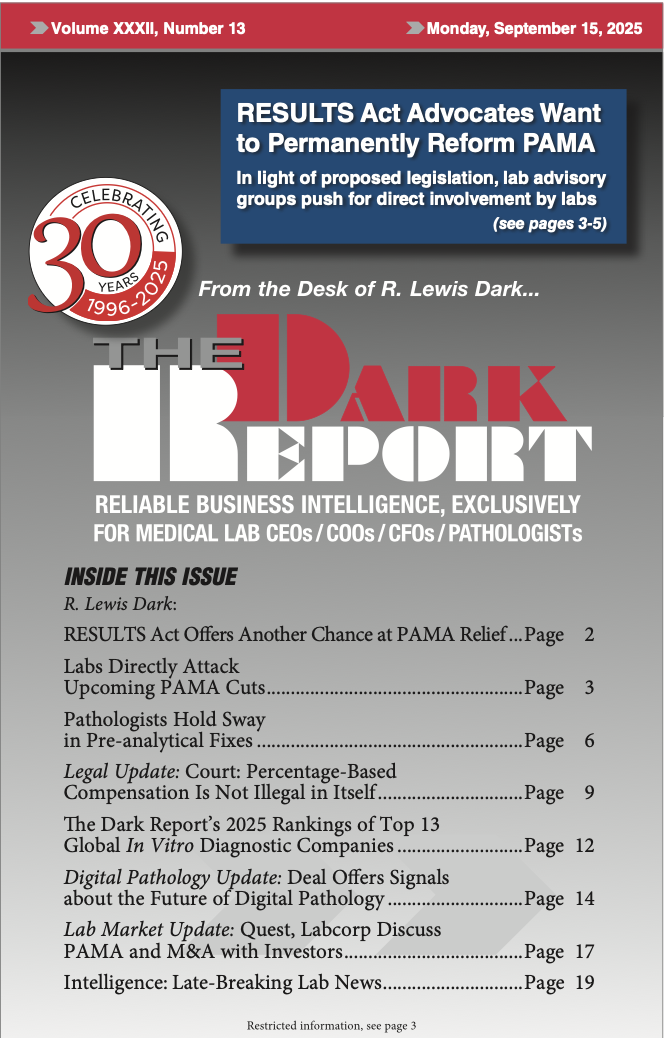Laboratory Management
Laboratory management in today’s clinical lab industry is changing rapidly and facing entirely new challenges. One problem is the lack of upcoming younger lab managers, as the retirements of baby boomer pathologists, medical technologists and lab scientists are in the near future. These individuals make up the largest proportion of supervisors, managers, and lab administrators working in labs today.
As they retire, every clinical lab and pathology group needs to have the next generation of leaders ready to step up and assume responsibilities. But, across the lab industry, there are limited opportunities for every lab’s brightest up-and-comers to get the regular management development opportunities that are common among Fortune 500 companies. The Dark Intelligence Group has called for the establishment of a mentoring program to help overcome this problem.
At the same time, downward pressure on reimbursements and mounting competition have created an environment that requires much more effort for a medical lab to grow and thrive.
Legislation, including the Health Information Technology for Economic and Clinical Health Act (HITECH) of 2009 and the Patient Protection and Affordable Care Act (PPACA) of 2010, have placed significant demands on medical laboratories and healthcare providers to improve internal efficiency even while offering more services for less money. This pressure to “do more with less” is further compounded by the need to deliver increasingly personalized client service to retain and win clients.
With the era of fee-for-service medicine coming to a close, every clinical laboratory and anatomic pathology organization needs a strategy for getting paid, as new reimbursement models that support patient-centric care will make up a larger portion of lab revenues.
The challenge for every clinical laboratory manager is to understand how to evolve from a business model that is accession-centric or volume-centric to one that is patient-centric.
Many clinical laboratories today are developing data repositories to logically link all transactional and other information about a patient. These repositories allow physicians to see all relevant information, identify trends, and provide better care as a result, enabling labs to provide greater value to their customers, patients and payers, thus creating more value and becoming more patient-centric.
Crises Management Plan Essential for Every Lab
By Robert Michel | From the Volume V No. 15 – November 9, 1998 Issue
CEO SUMMARY: “It can’t happen here” is not good management. All clinical laboratories and pathology practices should anticipate the worst and develop their own internal controls to prevent the unthinkable and prepare for the unexpected. Rogue phlebotomists like the one at SmithKline…
Legislators May Repeal NY Lab Surcharge Tax
By Robert Michel | From the Volume V No. 15 – November 9, 1998 Issue
CEO SUMMARY: After two years of concerted effort, laboratories in New York are optimistic that state legislators will finally repeal an 8.18% surcharge tax on clinical laboratory tests. The significant insight behind this story is how laboratories educated patients about the surcharge. Th…
Unilab Signs Agreement To Buy Bio-Cypher Labs
By Robert Michel | From the Volume V No. 15 – November 9, 1998 Issue
CEO SUMMARY: Unilab’s desire to purchase $60 million Bio-Cypher must be viewed against the impending acquisition by Quest Diagnostics of SmithKline Beecham Clinical Laboratories (SBCL). Whenever Quest takes control of SBCL’s lab operations, it automatically becomes a significant compe…
Client Service and Sales Fuel Fast Growth at AML
By Robert Michel | From the Volume V No. 15 – November 9, 1998 Issue
CEO SUMMARY: Here’s proof positive that effective management can make a positive difference in the financial performance of clinical labs. Upon taking title to American Medical Laboratories in the spring of 1997, its new owners used an emphasis on “customer-first” service and aggres…
Management Execution Part of AML’s Success
By Robert Michel | From the Volume V No. 15 – November 9, 1998 Issue
CEO SUMMARY: Swift and positive changes at American Medical Laboratories (AML) came as a direct result of energetic management. AML provides lab executives with an outstanding case study of how to take an existing, somewhat tranquil lab organization and turn it into a high-performance rev…
Unilab, DIANON Systems, UroCor Report 1998 Financial Results
By Robert Michel | From the Volume V No. 15 – November 9, 1998 Issue
OPTIMISM REIGNS at California-based Unilab Corporation. Revenues are up, operating profits are increasing, and company officials are now talking about growth plans. For 1998, Unilab generated revenues of $217.4 million, compared to $214.0 million in 1997. …
Movers & Shakers For ’99 Demonstrate Leadership
By Robert Michel | From the Volume V No. 15 – November 9, 1998 Issue
EACH YEAR IT BECOMES more difficult to make final selections for our annual Movers & Shakers awards. The reason is simple. Today there are more examples of leadership in the laboratory than when we first started these selections three years ago. This is a good omen. It means that the crucible of…
AmeriPath, Cytyc, NeoPath, Morphometrix, AutoCyte
By Robert Michel | From the Volume V No. 15 – November 9, 1998 Issue
AMERIPATH REPORTS RECORD YEAR & LOSES ITS CHAIRMAN MIXED SIGNALS RECENTLY EMERGED from AmeriPath, Inc., the country’s largest pathology PPM. It finished the year with strong financials and lost its chairman. On one hand, it finished its first full year as a public com…
Sales & Marketing Is Critical To Success Of Labs & Pathologists
By Robert Michel | From the Volume V No. 15 – November 9, 1998 Issue
CEO SUMMARY: Careful study of the most successful lab oratories operating today reveals a common characteristic: the effective use of sale s and marketing methods to boost specimen volume, revenue, and operating profits. This is true whether it’s a hospital lab outreach program, a comme…
First-Ever National Gathering Of Lab Sales Managers
By Robert Michel | From the Volume V No. 15 – November 9, 1998 Issue
CEO SUMMARY: Here’s a news-making event for the clinical laboratory industry: a first-ever national meeting of the country’s best sales and marketing managers. Scheduled as a new addition to the EXECUTIVE WAR COLLEGE on May 11-13, it’s an unprecedented opportunity for the nation’s…
CURRENT ISSUE

Volume XXXII, No. 13 – September 15, 2025
The Dark Report examines a new bill that would reform PAMA and avoid reimbursement rate cuts scheduled for January 2026. Clinical laboratory leaders are urged to make their voices heard in Congress. Also, an expert describes how labs can fix pre-analytical errors and avoid disaster.
See the full table of contentsHow Much Laboratory Business Intelligence Have You Missed?
Lab leaders rely on THE DARK REPORT for actionable intelligence on important developments in the business of laboratory testing. Maximize the money you make-and the money you keep! Best of all, it is released every three weeks!
Sign up for TDR Insider
Join the Dark Intelligence Group FREE and get TDR Insider FREE!
Never miss a single update on the issues that matter to you and your business.
Topics
- Anatomic Pathology
- Clinical Chemistry
- Clinical Laboratory
- Clinical Laboratory Trends
- Digital Pathology
- Genetic Testing
- In Vitro Diagnostics
- IVD/Lab Informatics
- Lab Intelligence
- Lab Marketplace
- Lab Risk & Compliance
- Laboratory Automation
- Laboratory Billing
- Laboratory Compliance
- Laboratory Equipment
- Laboratory Information Systems
- Laboratory Management
- Lean Six Sigma
- Managed Care Contracts
- Molecular Diagnostics
- Pathology Trends
- People
- Uncategorized

